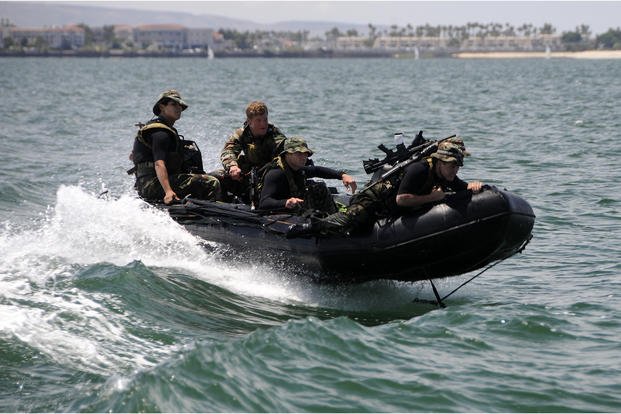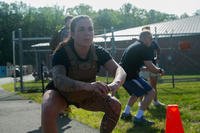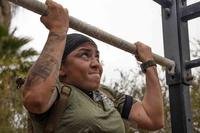The path to becoming a Navy SEAL is challenging, and the dropout rate during training is high. Candidates must have exceptional physical fitness in addition to mental resilience, to make the cut for this elite military unit.>
All roads to becoming a Navy SEAL, end at BUD/S -- Basic Underwater Demolition/SEAL training. There are many routes to get to sunny Coronado, California, where BUD/S is located, but the only way to become a Navy SEAL is to finish BUD/S first. Below are the several options SEAL wannabes struggle with and should know before signing any paperwork with the Navy:
First Option: Join the Navy by Enlisting
This is the route that will give you the best chance of attending SEAL training; there are 10 times more enlisted SEALs than there are officers who attend SEAL training. The need for enlisted SEALs therefore always will be higher than the need for officers in the teams. That is why the SEAL officer route is more competitive. Here is the way to join the Navy and get to BUDS the quickest. Many candidates attend BUD/S with college degrees as enlisted, with the hopes of going to Officer Candidate School (OCS) later in their career.
Step 1: Go to a recruiter's office. Choose a Spec Ops/Spec War Source Rating
You will have to sign up for a regular Navy Source Rating (designator -- like GM gunners mate or OS operations specialist) to join the Delayed Entry Program. Ask your local recruiter about the Navy Special Warfare/Special Operations mentor in your area. These former SEAL, EOD and divers are mentors for recruits, and their duties are to help recruits prepare for training by giving regularly scheduled physical screening tests (PST). You have to pass the PST with your mentor in order to change your rate to SO. SO, or special operator, will be your new designation after you pass the PST with competitive scores. However, you have to pass the elevated standards of the Navy SEAL PST before you will get the opportunity to attend boot camp, then BUD/S.
Navy SWCC Fitness Training Overview
Below are the minimum and recommended standards for the PST:
| PST Event | Minimum Standards | Recommended Standards |
| 500-yard swim | 12:30 | 8-9 minutes |
| Push-ups | 75 | 80-100 |
| Sit-ups | 75 | 80-100 |
| 80-100 | 15 | 15-20 |
| 1.5-mile timed run | 9:30 | 9 minutes |
Currently, Navy Special Warfare has instituted a "draft" where the best scores get submitted into a nationwide competition and the best candidates get selected first. The better your PST scores determines how soon you get to go to boot camp, then BUD/S, so achieving above (or beyond) the recommended standard is critical to your acceptance to go to SEAL training.
Recommendation -- Ace the PST on your own before you join the delayed entry program. Your process will go much smoother instead of being one of the weekly failures of the PST.
Step 2: Boot Camp Training
All recruits will report to Great Lakes, Illinois, to attend basic military training. During boot camp, you will be required to take and pass the Special Warfare/Operations PST again. If you pass at boot camp, you officially are in the pre-training community -- meaning you will get orders to attend BUD/S.
Step 3: Pre-Training Phase (Post-Boot Camp and Pre-BUD/S Training)
After boot camp, you will work out for a living and still live in Great Lakes in a program called BUD/S Prep. Your job is to learn about the Special Warfare communities as well as start an extensive physical training program for 6-8 weeks. The pre-training program is to help candidates get into better shape, because boot camp does not prepare a BUD/S student properly for their advanced training programs they will see in Coronado. Consider this the SO rating A school.
The pre-training instructors are not interested in weeding anyone out at this point; however, if you do not meet the standard, you will not get to attend BUD/S. The goal of this training is to teach candidates that they will not survive the next phase of training if they strive for the minimum standards in the PST.
Option #2: Enlist and Serve in the Navy, then Try Out for BUD/S
This is a longer route to BUD/S and applies to enlisted as well as officers in the Navy who want to attend BUD/S. It is also the same route a former BUD/S student who did not graduate will have to do if he wants to try to attend BUD/S again.
Imagine yourself at your regular Navy command, working during the day, then adding in extra workouts at night to prepare for the BUD/S PST. This will be your life for a year or two -- or more. The ability to get above-average PST scores is possible, but it requires lots of extra effort. It has been done before by many great enlisted and officer SEALs, but it is a challenge and demonstrates your desire to go to BUD/S if you can get the recommended elevated scores on the PST while on active duty -- especially if stationed on a ship.
You have to route a special request chit up your chain of command and have to wait until your time at your present command is completed before leaving for BUD/S. Many have arranged a deal to re-enlist in the Navy if they can attend BUD/S at the time of the end of their first enlistment. Of course, you still have to meet all of the elevated standards. For more information, go to the Navy SEAL and SWCC official site.
For the future BUD/S students in the fleet, there is a pre-BUDS program as well. It is called the fleet transition program, where students get TAD orders to attend before attending BUD/S. Look into the FTP in Little Creek, Virginia.
If you are in another service branch, you have to join the Navy to go to BUD/S. There is no such thing as joining the Marine Corps, then going to the BUD/S program. You can join the Marines, but you have to get out of the Marines and join the Navy to go to BUD/S. See the Navy SEAL and SWCC official site for more information.
Related Video:
Options #3: Navy SEAL Officer Programs: US Naval Academy
USNA to SEAL: First you have to get into the Naval Academy. Once at the academy, you should start training with like-minded classmates as well as get to know the older students who are training every day for BUD/S. There are active-duty SEALs to help with your training programs and will start the screening process your junior year. You will take many PSTs as well as have to endure BUD/S screening -- a 36-hour event that mixes in some of the worst events at BUD/S into a long weekend at the academy.
Usually by your senior year, the hundred or more classmates who thought they wanted to be SEALs has dwindled to 40-60, but they are all highly qualified and only 20-30 slots each year. Your grades, leadership jobs, sports and athletic events completed, foreign languages and even community service hours come into play into selection. You will be judged by a group of SEAL officers and senior enlisted in a personal interview while attending SEAL Officer Assessment and Selection Training. (official site info). An Academy midshipman will attend SOAS during the summer before their senior year.
Options #4: Navy SEAL Officer Programs: Reserve Officer Training Corps (ROTC)
Going to college under a Navy ROTC program is another route to get to BUD/S. Navy ROTC graduates have the opportunity to attend BUD/S after graduation. ROTC gets typically 15-25 officer slots a year for SEAL training. These are nationwide competitions among all ROTC programs in the nation. These are highly competitive, but if you are an excellent or above-average candidate, you have a great chance at going to BUD/S.
Your requirements are similar to that of USNA and OCS; your grades, sports, leadership roles and PST scores will play a part in your acceptance. See the official ROTC website for what colleges offer Navy ROTC. ROTC candidates also will attend SOAS the summer before their senior year.
Options #5: Navy SEAL Officer Programs: Officer Candidate School - OCS
You need to have a college degree before applying to the OCS board. There are many opportunities for young college grads seeking to lead in the military, but officer slots for any of the Special Forces units are few and hard to come by. In fact, the latest numbers for SEAL officer candidates were about one in eight get accepted to attend SEAL training after OCS.
Applying to Officer Candidate School and wanting to become a Navy SEAL means you actually will be selected to go to BUD/S immediately after you complete OCS. You will attend SOAS before attending OCS. If you do not get a billet after SOAS, you do not have to go to SOAS, unless you want to go as a different job in the Navy. You will be accepted to attend SEAL training by a board of SEAL officers after SOAS, and then they will send you to OCS first -- with immediate follow-on training at BUD/S.
Check out Seal Training Via Officer Candidate School
Step 4: Navy SEAL Training (BUD/S) PTRR and INDOC/BUD/S Orientation
Once you arrive at BUD/S, you will join PTRR (physical training rehabilitation and remediation) for a few weeks until the next INDOC class forms. BUD/S Indoctrination Phase (INDOC) is a challenging five- to six-week training to test the students thoroughly in the basics from the PST (again), swimming with fins, obstacle courses, timed beach runs, challenging PTs on the Grinder and surf zone training. Once you have passed the challenges of INDOC and not quit after the instructors personally test your desire, you get the opportunity to advance to Phase 1.
Step 5: Phase 1,2,3 at BUD/S
Now training begins at first phase. This is where most BUD/S students quit or get injured. This phase is where you will meet challenges regularly, such as four-mile timed beach runs, two-mile ocean swims, BUD/S obstacle course, log PT, hundreds of reps of push-ups, pull-ups and ab exercises. Drown-proofing, life saving and underwater knot tying also are challenging tests you must pass to continue training. Of course, there is Hell Week, a 120-hour-long event designed to test your desire to be a Navy SEAL. You may sleep a total of 3-4 hours in five days and log more than 200 miles of running, swimming and paddling boats. This phase is the ultimate test of your ability to be a team player; whether you are under a log or boat, you quickly will learn who you want on your team.
Phase 2 is dive phase. You should have a basic understanding of SCUBA diving before attending, though it is not a requirement to be SCUBA qualified. You will be required to use algebra to solve diving math problems as well as diving physics. The most important laws to know in Navy SEAL diving are Boyle's Law and Dalton's Law of Partial Pressure. You will learn open-circuit SCUBA and closed circuit (oxygen re-breathers) in Dive Phase as well as one of the most challenging tests at BUD/S -- pool competency. This test is designed to teach and test your ability to remain calm in the event of everything going wrong underwater. You also will swim a six-mile ocean swim during this phase.
Phase 3 is land warfare. You will enjoy shooting, learning and using demolitions such as C-4 as well as patrolling, shooting and moving, and land navigation. This phase is full of potential safety violations so be careful where you point your weapon, have your weapon on safe when not in use, as well as many other potential dangers that involve demolition and marksmanship. The PT, runs and swims do not get easier -- in fact, you will be in your best shape ever during third phase and able to run 10-15 miles, swim 3-4 miles and ruck 20 miles on San Clemente Island.
Congratulations. You have finished BUD/S, but your SEAL training is not over. Just the basics is over.
Check out these videos and get a glimpse inside SEAL BUD/s training in San Diego.
SEAL Qualification Training -- After BUD/S graduation, you go to SQT -- an advanced training program that takes the individual who graduated BUD/S and forms a team that is capable of operating in the water, underwater, from planes and helicopters, ropes and parachutes, boats, and on foot. You will learn and master the basic insertion methods used by SEALs and conduct training missions. There is also a mix of many hours of classroom training where you learn about intelligence gathering, designing missions and moving together as a team from insertion to extraction of a mission.
Now after BUD/S and SQT, you get to go to the SEAL team that selected you and become a "new guy" and prove yourself all over again to the veteran SEALs you will be joining on combat deployments. You will continue to learn something new each day of your career, so stay in "receive mode" and listen to those who have been there and done that.
Stew Smith is a former Navy SEAL and fitness author certified as a Strength and Conditioning Specialist (CSCS) with the National Strength and Conditioning Association. Visit his Fitness eBook store if you’re looking to start a workout program to create a healthy lifestyle. Send your fitness questions to stew@stewsmith.com.
Want to Learn More About Military Life?
Whether you're thinking of joining the military, looking for fitness and basic training tips, or keeping up with military life and benefits, Military.com has you covered. Subscribe to Military.com to have military news, updates and resources delivered directly to your inbox.



















